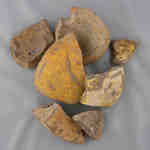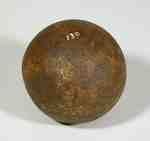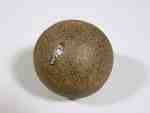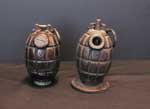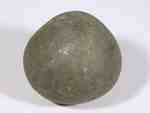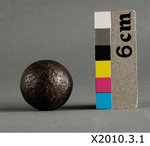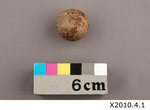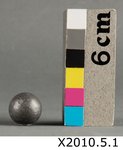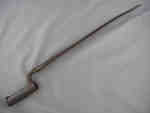Results
- Total length 49cm; blade 34cm. Leather with metal blade casing. On the hook "?? 29515". No other engraving or stampings.Total length 49cm; blade 34cm. Leather with metal blade casing. On the …
- Leather strap to affix to belt, metal casing for blade; blade 30cm long, total length 45.5cm. On metal between handle and blade, engraving "21 62" and on tab of metal blade casing, engraving "H2"Leather strap to affix to belt, metal casing for blade; blade 30cm …
- These are a group of cannon ball fragments. The cannon balls look to have been hollow inside.These are a group of cannon ball fragments. The cannon balls look …
- A 10 pound cannonball that is believed to have been used by either American or British forces. It was found near Nelles Blvd, in Grimsby, on land belonging to Col. Robert Nelles at the time of the WaA 10 pound cannonball that is believed to have been used by …
- A round solid iron cannonball, pitted. It is most likely from the Engagement at Forty Mile Creek on June 8, 1813.A round solid iron cannonball, pitted. It is most likely from the …
- Referred to in "Guns Through the Ages" by Geoffrey Boothroyd.Referred to in "Guns Through the Ages" by Geoffrey Boothroyd.
- #1 - no base; cotter pin & lever intact; on front "M"; on bottom "36M MK1"; 9.5cm in height #2 - added base plate; cotter pin & lever intact; screw plug missing; on fron "M & P"; on back, below lever#1 - no base; cotter pin & lever intact; on front "M"; …
- Metal blade casing, leather belt strap, blade 37cm long; total length 53cm.Metal blade casing, leather belt strap, blade 37cm long; total length 53cm.
- A cannonball believed to be from the War of 1812.A cannonball believed to be from the War of 1812.
- A powder horn with brass fittings at both ends. There is one brass ring remaining to which some material such as hide or leather would have been fastened for carrying purposes. At the narrow end therA powder horn with brass fittings at both ends. There is one …
- This Land/India Pattern bayonet was produced by the British Government ca. 1730-1815. This type of bayonet was used during the War of 1812. With a 17 inch blade and flat top, the bayonet gradually naThis Land/India Pattern bayonet was produced by the British Government ca. 1730-1815. …
- Referred to "The Military Arms of Canada" by The Upper Canada Historical Arms Society and "The British Military Longarms 1715-1815' by D.W. Bailey.Referred to "The Military Arms of Canada" by The Upper Canada Historical …
- This type of ammunition, known as a grapeshot, was used in artillery during the War of 1812. A round black ball of iron with a pitted surface, this grapeshot has a circumference of 4 1/8 inches. GrapThis type of ammunition, known as a grapeshot, was used in artillery …
- This is an example of ammunition used in artillery during the War of 1812. Commonly termed a grapeshot, this round grayish ball of lead has a circumference of 3 3/4 inches. The surface is not smoothThis is an example of ammunition used in artillery during the War …
- This type ammunition was used in a musket during the War of 1812. A small round silver ball of lead, this musket ball is 2 1/8 inches in circumference. The surface is shiny and smooth with a visibleThis type ammunition was used in a musket during the War of …
- This iron fashioned ammunition was created during the War of 1812 period. It gives an insight into the appearance of military munitions during the 1812 time. Diameter: 3.2 cmThis iron fashioned ammunition was created during the War of 1812 period. …
- This is a bayonet that would have been designed to fit on the muzzle of a Brown Bess musket. There is an inscription on the base of the stock that looks to be an underlined “A” with “33” below.This is a bayonet that would have been designed to fit on …
- A homemade bayonet that was designed to fit on the muzzle of a rifle or musket. It is of the styling favored most by the militia units during the War of 1812. Its unique length and lack of a rear reiA homemade bayonet that was designed to fit on the muzzle of …










